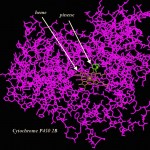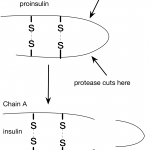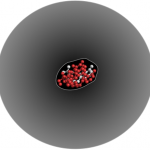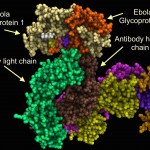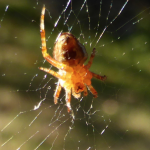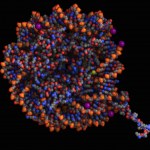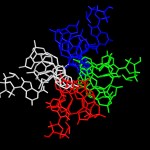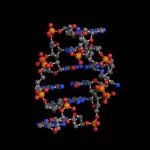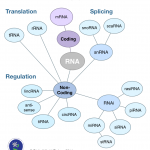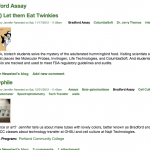
On pinene and inhibiting enzymes.
People of a certain age may remember a series of really funny commercials featuring Euell Gibbons and his famous question about whether you've ever eaten a pine tree. "Some parts are edible" said Euell.
Perhaps some parts are, but other pine tree products aren't so nourishing. Crystallography365, aka @Crystal_in_city had a couple of fun blog posts about pinene, a chemical made by pine trees, that also inhibits cytochrome P450 2B6.
I was inspired by their posts and by my experience with Cytochrome P450 to go a little…
In my last post, I wrote about insulin and interesting features of the insulin structure. Some of the things I learned were really surprising. For example, I was surprised to learn how similar pig and human insulin are. I hadn't considered this before, but this made me wonder about the human insulin we used to give to one of our cats. How do cat and human insulin compare?
It turns out, that all vertebrates produce insulin, even frogs and zebra fish. Human preproinsulin is only 110 amino acids long and even human and fish insulin are pretty similar…
Sucrose
Molecules of sucrose tore apart in their bellies letting glucose course free in their veins.
Luckily for us, a system evolved long ago to capture that glucose and minimize it's potential for damage. Removing sugar from the blood and sequestering it in liver, fat, and muscle cells, minimizes the harm that might result if sugars were free to bind to proteins and our bodies were stressed by trying to flush excess glucose out of our system.
This holiday season, we give thanks for insulin and the biotech companies like Genentech that cloned the human gene and began to…
Scale, proportion, and quantity belong to one of the cross cutting concepts in the next generation science standards (NGSS). According to Volume 2 of the NGSS, "in engineering, no structure could be conceived much less constructed without the engineer's precise sense of scale." The authors go on to note that scale and proportion are best understood using the scientific practice of working with models.
When scientists and engineers work with these concepts at a molecular scale, new kinds of technologies can be created to advance our understanding of…
In 1925, dogsledders raced through the frozen Alaskan bush to bring antiserum to the isolated village of Nome. The antiserum arrived in time, saved the lives of many villagers from the horrors of diphtheria, and inspired the Iditarod, a famous race in celebration of the dog sledders' heroic feat.
West Africa could use a similar effort today. Richard Harris's blog at NPR has a good story about doctors' efforts to develop and use antiserum to treat Ebola. According to ABC news, Dr. Kent Brantly, who is being seen at Emory University Hospital was treated…
What’s the first you think about when you see a spider? Running away? Danger? Fairies? Spiderman?
Do you wonder if spider silk is really strong enough to stop a train, like they showed in Spiderman 2?
Whatever your thoughts, you’re probably not thinking about 3D printing in space. Yet, the time might be near when astronauts will be using 3D printers filled with spider silk to make replacement parts in space. I learned about this idea in a presentation from Dr. Ron Sims, Utah State University, at the Bioman conference at Salt Lake Community College a couple of…
Living in Seattle fosters a certain pessimism when it comes to large companies. Boeing has always been a poster child for employment uncertainty, regularly hiring large numbers of people and just as regularly, laying them off. Now, we have Microsoft and Amgen joining the club, with Microsoft layoffs impacting an estimate 1350 people in the area, and Amgen, planning to shed 660 jobs when it closes facilities in Seattle and Bothell. Sometimes as a biotech educator, it’s hard to reconcile the prospects of knowing we're training students for well-paying, interesting…
Science and its interpretation is wonderful. Today I saw a post on Twitter from @LAbizar, referencing an @GEN, post that stated 8.2% of Human DNA is Functional with a link to a GEN article: "Surprise: Only 8.2% of Human DNA Is Functional." The GEN writeup cited a PLoS Genetics article, "8.2% of the Human Genome Is Constrained: Variation in Rates of Turnover across Functional Element Classes in the Human Lineage," released today.
How much of the human genome is functional?
In 2012, the ENCODE (Encyclopedia of DNA Elements) project published a landmark…
A few weeks back, we published a review about the development and role of the human reference genome. A key point of the reference genome is that it is not a single sequence. Instead it is an assembly of consensus sequences that are designed to deal with variation in the human population and uncertainty in the data. The reference is a map and like a geographical maps evolves though increased understanding over time.
From the Wiley On Line site:
Abstract
Genome maps, like geographical maps, need to be interpreted carefully. Although maps are essential to exploration and navigation they…
A key concept in science is molecular scale. DNA is a fascinating molecule in this regard.
While we cannot "see" DNA molecules without the aid of advanced technology, a full length DNA molecule can be very long. In human cells, other than sperm and eggs, six billion base pairs of DNA are packaged into 22 pairs of chromosomes, plus two sex chromosomes. Each base pair is 34 angstroms in length (.34 nanometers, or ~0.3 billionths of a meter), so six billion base pairs (all chromosomes laid out head to toe) form a chain that's two-meters long. If we could hang this DNA chain from a hook, it…
Replication fork - http://en.wikipedia.org/wiki/Telomere.
Organisms with linear chromosomes have to solve the problem that DNA replication makes them shorter. This is due to the fact that DNA polymerase can only add bases to the terminal 3'-OH of a DNA chain. The DNA replication initiation complex uses RNA primers to provide the initial 3'-OH and to initiate "lagging" strand synthesis. While one strand can be copied all the way to the end of a chromosome, the other, lagging strand, must be primed at short intervals in order to provide a 3' OH group for DNA polymerase as the…
Today (4/25) is national DNA day. Digital World Biology™ is celebrating by sharing some of our favorite structures of DNA. We created these photos with Molecule World™ a new iPad app for viewing molecular structures.
As we are taught in school, the double stranded DNA molecule is a right-handed helix as determined by Watson and Crick using Franklin's x-ray diffraction images [1]. This B-form of DNA has approximately 10 nucleotides per turn of the helix and is the most common form of DNA found in nature.
Classic structure with the elements colored.
Classic structure…
In our series on why $1000 genomes cost $2000, I raised the issue that the $1000 genome is a value based on simplistic calculations that do not account for the costs of confirming the results. Next, I discussed how errors are a natural occurrence of the many processing steps required to sequence DNA and why results need to be verified. In this and follow-on posts, I will discuss the four ways (oversampling, technical replicates, biological replicates, and cross-platform replicates) that results can be verified as recommended by Robasky et. al. [1].
The game Telephone teaches us how a…
Previously, I introduced the idea that the $1000 genome has not been achieved because it is defined in simplistic terms that ignore many aspects of data completeness and verification. In that analysis, I cited a recent perspective by Robasky, Lewis, and Church [1] to present concepts related to the need to verify results and the general ways in which this is done. In this and the next few posts I will dig deeper into the elements of sequence data uncertainty and discuss how results are verified.
Agarose gel of DNA stained with ethidium bromide. By Mnolf, wikipedia.
First, we need to…
Getting an accurate genome sequence requires that you collect the data at least twice argue Robasky, Lewis, and Church in their recent opinion piece in Nat. Rev. Genetics [1].
The DNA sequencing world kicked off 2014 with an audacious start. Andrew Pollack ran an article in the New York Times implying that 100,000 genomes will be the new norm in human genome sequencing projects [2]. The article focused on a collaboration between Regeneron and Geisinger Health in which they plan to sequence the exomes (the ~2% of the genome that encodes proteins and some non-coding RNA) of 100,000…
By @finchtalk (Todd Smith)
In 2014 and beyond Finchtalk will be contributing to Digitalbio’s blog at this site. We kick off 2014 with Finchtalk’s traditional post on the annual database issue from Nucleic Acids Research (NAR).
Biological data and databases are ever expanding. This year was no exception as the number of databases tracked by NAR grew from 1512 to 1552. In the leadoff introduction [1] the authors summarize this year’s issue and the status of the NAR index. The 21st issue includes 185 articles with 58 new databases and 123 updates. In the 1552 database repository, 193 had their…
Yesterday, I wrote about students using science blogging as a way to develop an on-line portfolio and document their skills. One friend wrote me this morning and asked if my instructions to our students were really as simple as I described.
Well, no.
In fact, it wasn't easy to persuade my colleagues that we should let students blog. I had to promise them I would scrutinize every post and make sure no one got in trouble. Luckily, our student bloggers are responsible adults. Reading their posts has been a pleasure and there have only a couple of cases where I checked…
Why should students blog about science? Don't they have enough to do already?
Last Thursday night I participated in a panel discussion about science blogging (see the video) at ScienceOnline Seattle (#scioSEA)(video) and mentioned that we have two students blogging for us at Bio-Link. A question I saw afterward via Twitter, from @NurhafizPiers was this:
what is the purpose of the blog for the student?
I didn't get to answer the question Thursday night, so I'll answer now.
We're doing an experiment. My student bloggers and I are going to try and figure out if their blogs…
Tonight, I'm going to be speaking on a panel at the University of Washington with fellow science bloggers:
Alan Boyle (@b0yle) from CosmicLog and some company called "NBC" news.
(I only watch TV programs on Netflix and iTunes, these days, so I forget TV stations still exist.)
Brendan DeMelle (@bdemelle) from DeSmog Blog, and the Huffington Post
and Adrienne Roehrich (@fiainros) from Double X Science
More details and event information can be found at our event page at Seattle Science Online. #ScioSEA
Photo courtesy of Mandy…
If you want to work in biotech, you have to get work experience. But, how do you find it?
One way to find work experience is to do an internship.
When do I look?
If you're a college student, and you're planning to wait until spring to apply for a summer internship, you're waiting too long. The time to look is NOW. Many of the best internship opportunities appear between the beginning of December and end of February.
Where do I look?
As far as where, quite a few places have regular internship programs. I listed some examples below.
[View the story "'tis the season - to apply for summer…
